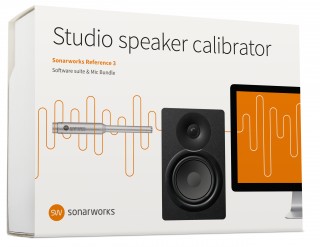 Sonarworks has released their newest speaker calibration software for sound studios and home recording, Sonarworks Reference 3.
Sonarworks has released their newest speaker calibration software for sound studios and home recording, Sonarworks Reference 3.
Reference 3 is designed to let anyone to do the complete studio calibration process, with a visual step-by-step workflow, in less than 15 minutes.
Reference 3 utilizes a proprietary Perceived Acoustic Power Frequency Response (PAPFR) technology that measures and analyzes sound the way humans actually hear it. During the measurement process, the software automatically detects the microphone position in the room, making the process much easier and the results more consistent.
The processing plugin has a filter engine that is specifically designed for audio calibration in a studio setting with a choice of linear, mixed, and minimum phase filters to suit the task at hand.
The calibration process is simple: first measurements are made in the studio with a measurement microphone. Reference 3 then analyzes the data and produces a filter profile for the studio. The filter is then opened with a plug-in in DAW just before sending a signal out to the monitors. When the plugin is enabled, the monitors are calibrated towards a chosen reference.
Pricing and Availability
Sonarworks Reference 3 measurement software is currently available for Mac. PC users can use version 2.2, which will be upgraded free of charge to 3.0 in spring 2015. The DAW plug-in is available for both OSX and Windows.
The company is currently offering a free and fully functional 21-day software trial of the Sonarworks Reference 3 software. A measurement microphone is required to use the software.
Sonarworks offers a bundled version with a custom calibrated measurement microphone for 269.00 EUR / 345.00 USD. A download only license is currently 229.00 EUR / 299.00 USD. Both bundles contain one measurement software license and two plug-in licenses.

The idea behind this is great, I’d love to be able to calibrate my studio, but my gut tells me the results are going to vary wildly and results still may not translate to the real world!
Plus having to use a plugin to constantly alter the sound? This would mean running all my hardware through some kind of plugin host…
I don’t know…
Any other options for going through this process out there?
Nice news… Just need to know the difference, in term of quality of algorithm analysis, with other solutions already existing : IK Arc’s, KRK Ergo, FuzzMeasure, Event Electronics StudioEQ, etc… A test would be a good idea to compare these tools, exactly in the same conditions.
I’d like to see a comparison test myself. My guess is all those you listed would give differing results in identical spaces.
Currently Dirac live is the most accurate solution and is the only room eq that can sit on top of windows audio stack. I’ve only just tested Sonarworks. The measurement process is far more intensive than anything else I’ve seen so far so thats a plus. I haven’t gotten a chance to hear the corrections yet.
I’ve tried ergo, msc-1, ik arc, and dirac live and so far dirac has been the only one that is usable. The rest sound really weird.
the idea is great, the price, not so much
The price is actually the lowest out of all room eq options. Initial testing shows sonarworks to be potentially the best option there is ATM. I really want to do a review and compare them all.
All these calibration plugins are designed for the same problem : bad acoustics. Although it’s much more expensive and complicated to properly treat a room, the resulting translateability of anything mixed in it will be much higher this way. And the sound stage will be bigger and clearer, not just flatter.
Hey!
Thanks for the comments everyone! Regarding other digital room correction solutions, be sure that we tried all of the popular ones and we set our goal to best them. Our beta testers did direct comparisons with ARC2 and Reference 3 came out on top, according to everyone who did the comparison.
Here’s a useful blog post about our software calibrating 5 mid-tier studio monitors in a regular ‘bedroom’ type studio – http://sonarworks.com/2014/08/studio-monitor-test-2014-08/
We offer a demo package with a calibrated measurement mic, if you don’t like just send it back we’ll refund the purchase.
Best,
Rudolfs
My conclusion on ARC1 and 2 is that it totally sucks and is unusable.
They make a headphone calibration plugin too, its still in beta but they claim “perfectly neutral sound”
Right you are! The plug-in was released about a month ago and is available for sell.
If you have any of these headphones –
AKG K141 MKII
AKG K701
AKG K712 Pro
Sennheiser HD598
Sennheiser HD600
Sennheiser HD650
Sony MDR-7506
Superlux HD681
Then you can just download it and give it a whirl!
I have both the Sonarworks and the ARC 2 and i can say with confidence that the Sonarworks is the superior system. I have used an Earthworks mic to measure the room and the result is very convincing. My mixes translate very well in to the real world. The only thing i find really annoying (At least on my system) is that it is virtually impossible to use when you are recording. The latency it generates quickly becomes an issue. This is espacially problematic when you are recording midi stuff. It is still a smal price to pay for mixing in the box. When you are working on mixing tasks this is not an issue at all. Just remember to turn it of when you are rendering your stuff down. This system is actually pretty cheap compared to stuff we are using live. (Smart etc.)
My system at home: iMac 16 gb ram – Apogee – Sceptre monitors(Presonus) – Logic x ++++ Macbook pro for live recording with Midas m32 r + Midas 32/16 stagebox.